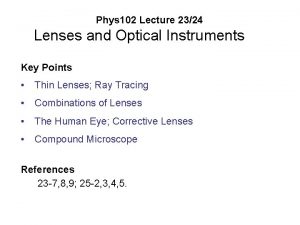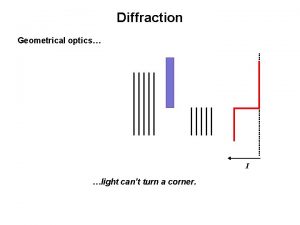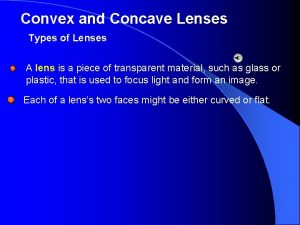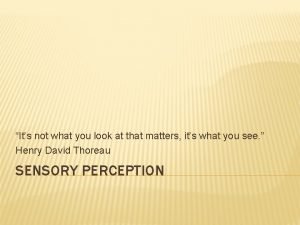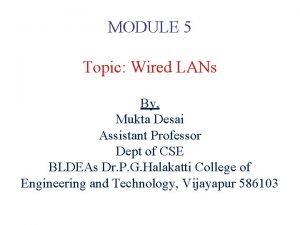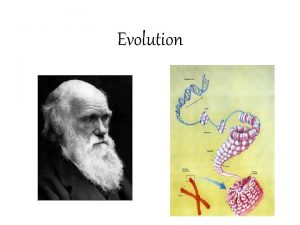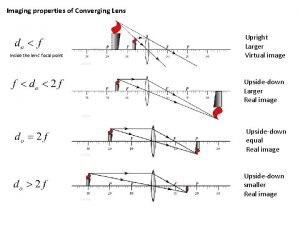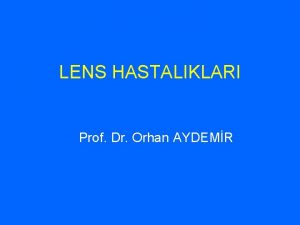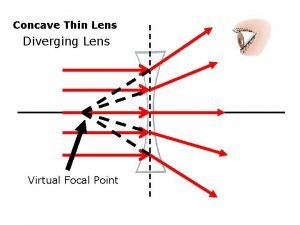You can look at evolution through 2 lens









































- Slides: 41


You can look at evolution through 2 lens

Evolution: Macro Lens • Macroevolution generally refers to evolution above the species level. • Species=a reproductively isolated population able to interbreed and produce fertile offspring

• Mutation: Some “green genes” randomly mutated to “brown genes” (although since any particular mutation is rare, this process alone cannot account for a big change in allele frequency over one generation).

• Migration (or gene flow): Some beetles with brown genes immigrated from another population, or some beetles carrying green genes emigrated

• Genetic drift: When the beetles reproduced, just by random luck more brown genes than green genes ended up in the offspring. In the diagram at right, brown genes occur slightly more frequently in the offspring (29%) than in the parent generation (25%).

Genetic Drift affects small or large populations more? Why? Small Pop Large Pop

• Natural selection: Beetles with brown genes escaped predation and survived to reproduce more frequently than beetles with green genes, so that more brown genes got into the next generation.

Q 1 In Amish populations, the incidence of a certain type of dwarfism is much higher than those of other populations. What principle explains this? A founder effect B genetic drift C natural selection D sexual selection

Darwin’s Theory • • Variation in individuals Competition Death to those without an advantage Differentiated reproduction Pass traits to offspring Fitness=more offspring=more fit Evidence of evolution—fossils, embryos, homologous structures, DNA

Q 2: This picture illustrates what type of selection? A sexual B disruptive C directional D stabilizing

Some phenotypes are selected FOR and some AGAINST


Evidence for evolution Comparative anatomy Embryology Biogeography Fossil record Molecular biology

Q 3: The amino acid sequence of cytochrome c is exactly the same in humans and chimpanzees. There is a difference of 13 amino acids between the cytochrome c of humans and dogs, and a difference of 20 amino acids between the cytochrome c of humans and rattlesnakes. Which of the following statements is best supported by these data? (A) Rattlesnakes apparently gave rise evolutionarily to the dog, chimpanzee, and human. (B) Cytochrome c apparently has an entirely different function in rattlesnakes than in mammals, which explains the difference in the number of amino acids. (C) Cytochrome c is not found universally in animals. (D) Cytochrome c from a rattlesnake could function in a dog, but not in a chimpanzee. (E) The human is apparently more closely related to the chimpanzee than to the dog or rattlesnake.

Q 3: The amino acid sequence of cytochrome c is exactly the same in humans and chimpanzees. There is a difference of 13 amino acids between the cytochrome c of humans and dogs, and a difference of 20 amino acids between the cytochrome c of humans and rattlesnakes. Which of the following statements is best supported by these data? • (A) Rattlesnakes apparently gave rise evolutionarily to the dog, chimpanzee, and human. • (B) Cytochrome c apparently has an entirely different function in rattlesnakes than in mammals, which explains the difference in the umber of amino acids. • (C) Cytochrome c is not found universally in animals. • (D) Cytochrome c from a rattlesnake could function in a dog, but not in a chimpanzee. • (E) The human is apparently more closely related to the chimpanzee than to the dog or rattlesnake.

Cladogram Review




Allopatric vs Sympatric Species

Evolution: Micro • Microevolution is evolution on a small scale— within a single population. That means narrowing our focus to one branch of the tree of life. • You could continue zooming in until you saw the relationships between beetle populations.

• We’ve defined microevolution as a change in gene frequency in a population and a population as a group of organisms that share a common gene pool • Imagine that you go to the mountaintop this year, sample these beetles, and determine that 80% of the genes in the population are for green coloration and 20% of them are for brown coloration. • You go back the next year, repeat the procedure, and find a new ratio: 60% green genes to 40% brown genes.

Hardy Weinberg Review • Population symbols—p 2, 2 pq, q 2 • Allele frequency symbols—p and q Look at what is given and what you have to solve for

Q 4 A survey reveals that 25% of a population of 1000 have attached earlobes, homo recessive trait. What is the frequency of recessive allele? __ What % are heterozygous? ___

Q 5: Which of the following factors is the most effective in changing allele frequency in natural populations? A Large population size B Low rate of mutation C Negligable migration D Random mating E Selection

Q 5: Which of the following factors is the most effective in changing allele frequency in natural populations? A Large population size B Low rate of mutation C Negligable migration D Random mating E Selection

Q 6: Evolutionary fitness is measured by A. Physical strength B. Reproductive success C. Length of life D. Resistance to disease E. Competiveness

Q 6: Evolutionary fitness is measured by A. Physical strength B. Reproductive success C. Length of life D. Resistance to disease E. Compeitiveness

Q 7: All of the following are examples of prezygotic isolating mechanisms EXCEPT: A Male fireflies of different species have different flash patterns B Three closely related orchid species flower on different days C The progeny of a cross between two different lizard species fail to develop properly D One species of snake lives in water and another is terrestial E Pepper frogs mate in April, and tree frogs mate in June

Q 7: All of the following are examples of prezygotic isolating mechanisms EXCEPT: A Male fireflies of different species have different flash patterns B Three closely related orchid species flower on different days C The progeny of a cross between two different lizard species fail to develop properly D One species of snake lives in water and another is terrestial E Pepper frogs mate in April, and tree frogs mate in June

Q 8: Two fossil vertebrates, each representing a different class, are found in the undisturbed rock layers of a cliff. One fossil is a representative of the earliest amphibians. The other fossil, found in an older rock layer below the amphibian, is most likely to be (A) A dinosaur (B) A fish (C) An insectivorous mammal (D) A snake (E) A bird

Q 8: Two fossil vertebrates, each representing a different class, are found in the undisturbed rock layers of a cliff. One fossil is a representative of the earliest amphibians. The other fossil, found in an older rock layer below the amphibian, is most likely to be (A) A dinosaur (B) A fish (C) An insectivorous mammal (D) A snake (E) A bird

1. Appearance of terrestrial plants 2. Appearance of chloroplasts 3. Formation of complex organic compounds 4. Development of photosynthetic organisms 5. Development of anaerobic prokaryotes Q 9: From the list above, which is most likely chronological order of events, from oldest to most recent, in the history of the Earth? A 1, 2, 4, 5, 3 B 3, 2, 5, 4, 1 C 3, 5, 4, 2, 1 D 5, 2, 3, 1, 4 E 5, 2, 4, 3, 1

1. Appearance of terrestrial plants 2. Appearance of chloroplasts 3. Formation of complex organic compounds 4. Development of photosynthetic organisms 5. Development of anaerobic prokaryotes Q 9: From the list above, which is most likely chronological order of events, from oldest to most recent, in the history of the Earth? A 1, 2, 4, 5, 3 B 3, 2, 5, 4, 1 C 3, 5, 4, 2, 1 D 5, 2, 3, 1, 4 E 5, 2, 4, 3, 1

Q 10: The different species of finches on the Galapagos Islands are believed to have arisen as a result of natural selection acting on populations of finches that had experienced A convergent evolution B gene flow C the bottle neck effect D geographic isolation E hybrid sterility

Q 10: The different species of finches on the Galapagos Islands are believed to have arisen as a result of natural selection acting on populations of finches that had experienced A convergent evolution B gene flow C the bottle neck effect D geographic isolation E hybrid sterility

Q 11: Adaptations that have enabled vertebrates to survive on land include all of the following EXCEPT: A a water-resistant epidermis B development of a bony skeleton C development of lungs D external fertilization E embryos enclosed within membranes

Q 11: Adaptations that have enabled vertebrates to survive on land include all of the following EXCEPT: A a water-resistant epidermis B development of a bony skeleton C development of lungs D external fertilization E embryos enclosed within membranes

Q 12: If organisms A, B and C belong to the same order but to different families and if organisms D, E and F belong to the same family but to different genera, which of the following pairs of organisms would be expected to show the greatest degree of structural homology? A B C D E A and B A and C B and D C and F E and F

Q 13: If organisms A, B and C belong to the same order but to different families and if organisms D, E and F belong to the same family but to different genera, which of the following pairs of organisms would be expected to show the greatest degree of structural homology? A B C D E A and B A and C B and D C and F E and F
 Look up look down
Look up look down If you think you can you can poem
If you think you can you can poem I know nothing is impossible
I know nothing is impossible Lens equation
Lens equation Fresnel and fraunhofer diffraction difference
Fresnel and fraunhofer diffraction difference Convex vs concave
Convex vs concave Thin lens equation rearranged
Thin lens equation rearranged If you can imagine it you can achieve it
If you can imagine it you can achieve it If you can't measure it it does not exist
If you can't measure it it does not exist If you can’t measure it, you can’t manage it
If you can’t measure it, you can’t manage it You can t manage what you can t measure
You can t manage what you can t measure Liquide mittel
Liquide mittel Look at the pictures and complete with can or can't
Look at the pictures and complete with can or can't Look at the pictures and say what their jobs are
Look at the pictures and say what their jobs are It's not what you look at that matters, it's what you see.
It's not what you look at that matters, it's what you see. Don't let anyone look down on you because you are young
Don't let anyone look down on you because you are young Everywhere you go everywhere you look
Everywhere you go everywhere you look Wired lans ethernet
Wired lans ethernet Four generations of ethernet
Four generations of ethernet Ethernet evolution through four generations
Ethernet evolution through four generations Ethernet evolution through four generations
Ethernet evolution through four generations Activity 1 picture identification
Activity 1 picture identification 1 look at the picture
1 look at the picture 1.look at the picture
1.look at the picture Kinds of comparison
Kinds of comparison You can tell harris about it just ____(easily) as i can
You can tell harris about it just ____(easily) as i can Positive comparative superlative
Positive comparative superlative Scan text
Scan text What are reference materials
What are reference materials Sin entered through one man
Sin entered through one man Through and through furcation
Through and through furcation Tangential timber conversion
Tangential timber conversion Night of the scorpion summary
Night of the scorpion summary You can't turn right here you – turn left
You can't turn right here you – turn left So you think you can argue
So you think you can argue Jared peet
Jared peet The more you care the stronger you can be
The more you care the stronger you can be So you think you can argue
So you think you can argue Go straight ahead and turn right
Go straight ahead and turn right You can be just the one you wanna be
You can be just the one you wanna be I can hear you quite well. you not shout
I can hear you quite well. you not shout You can argue
You can argue



